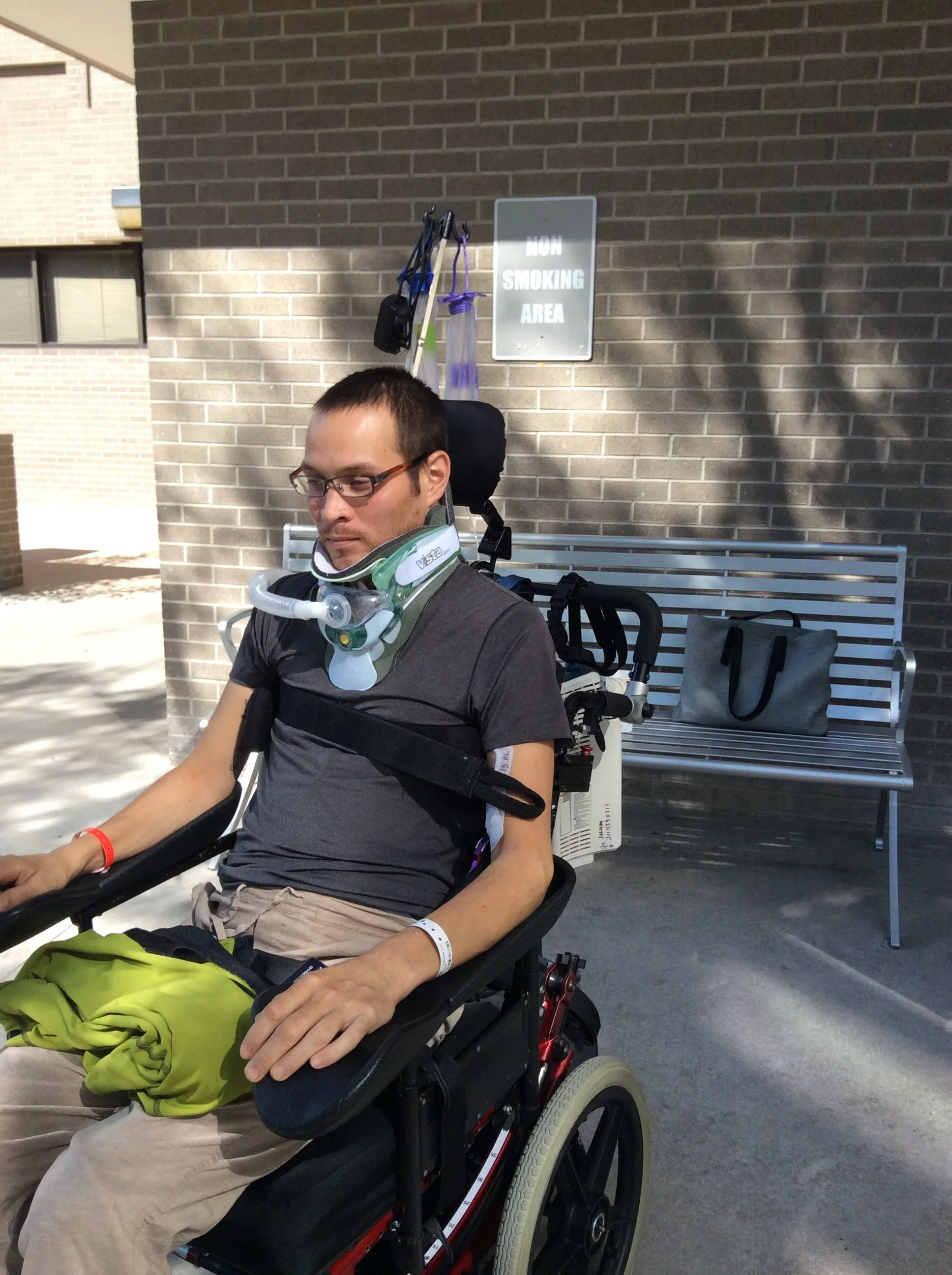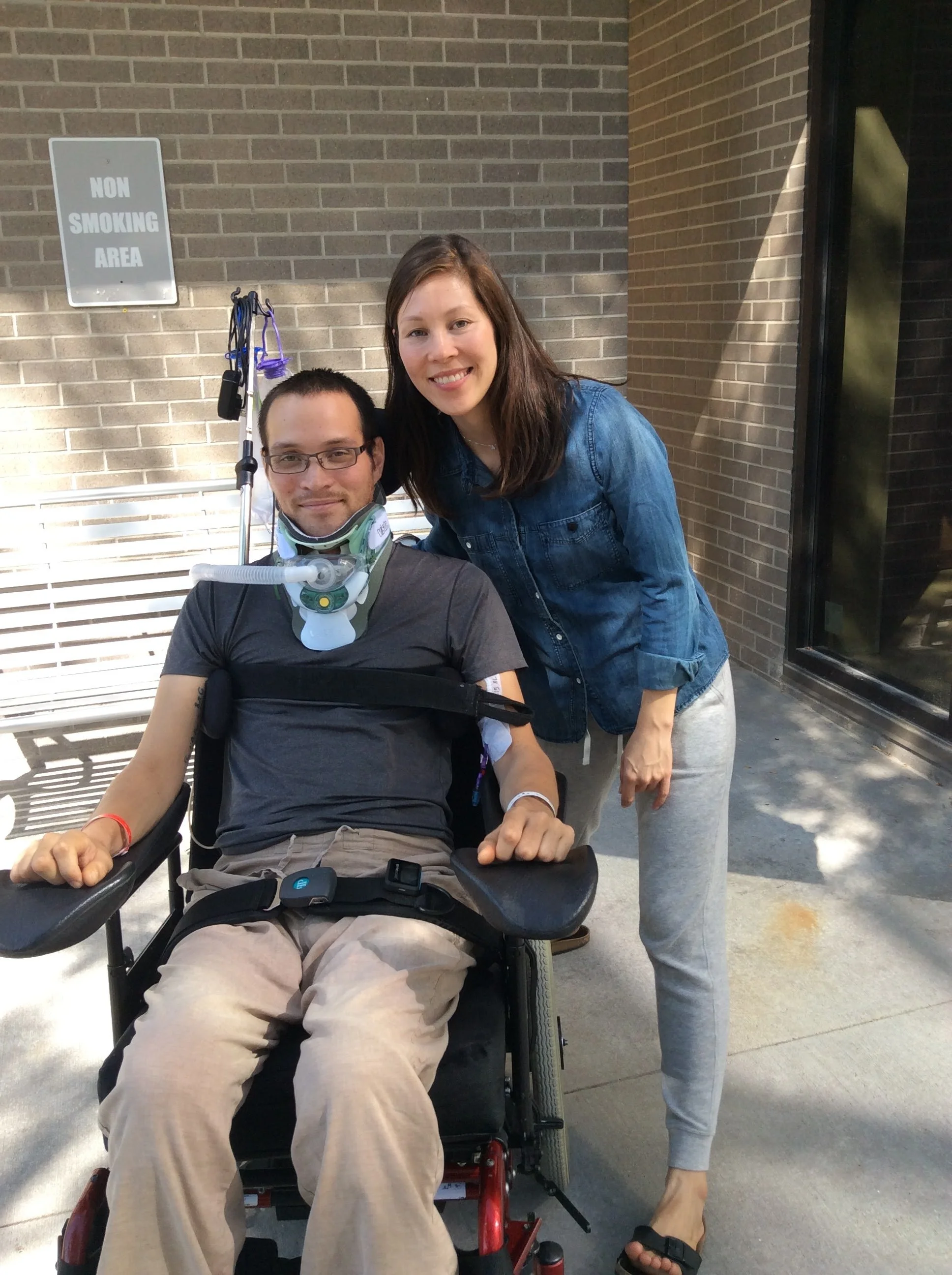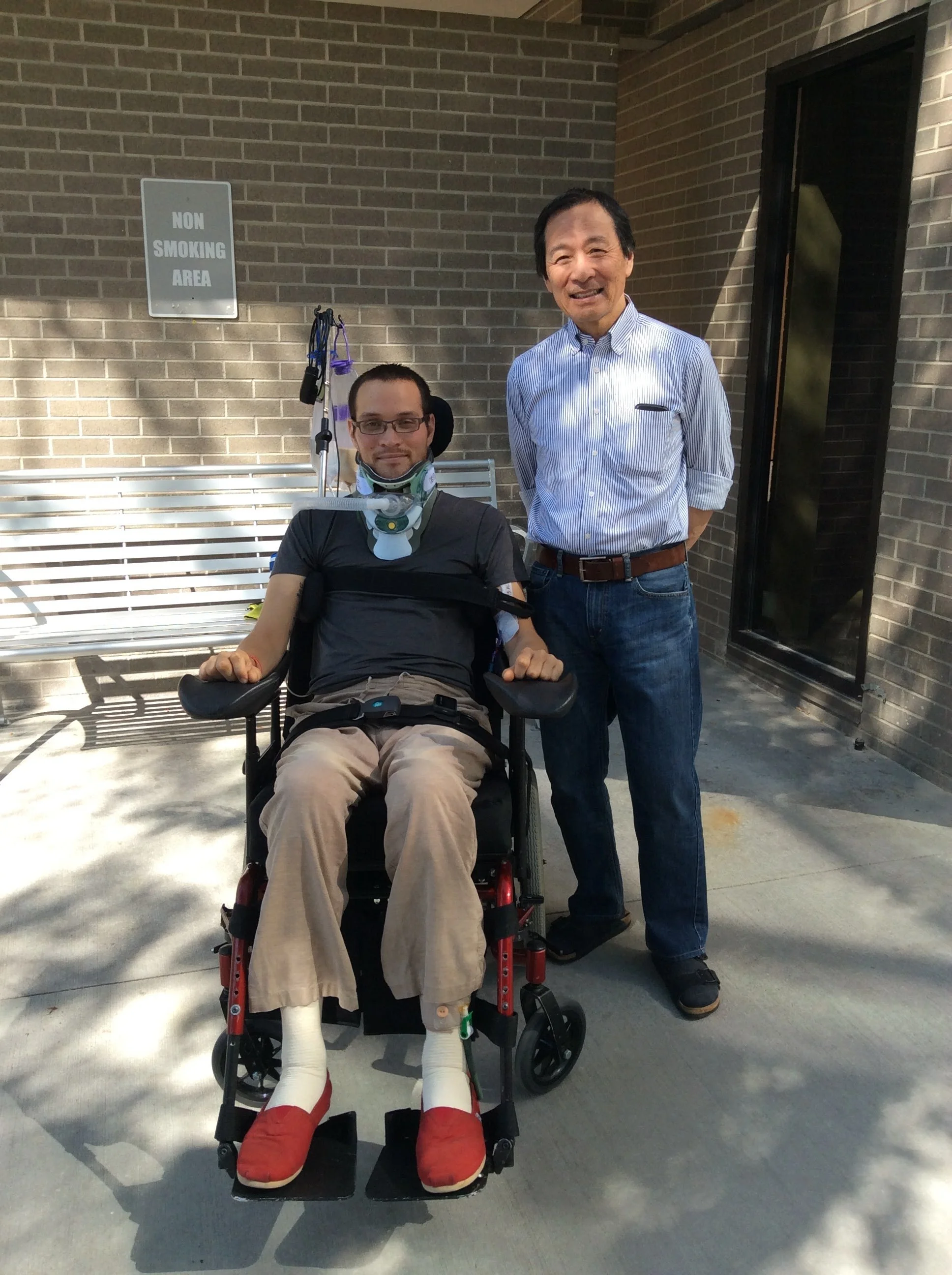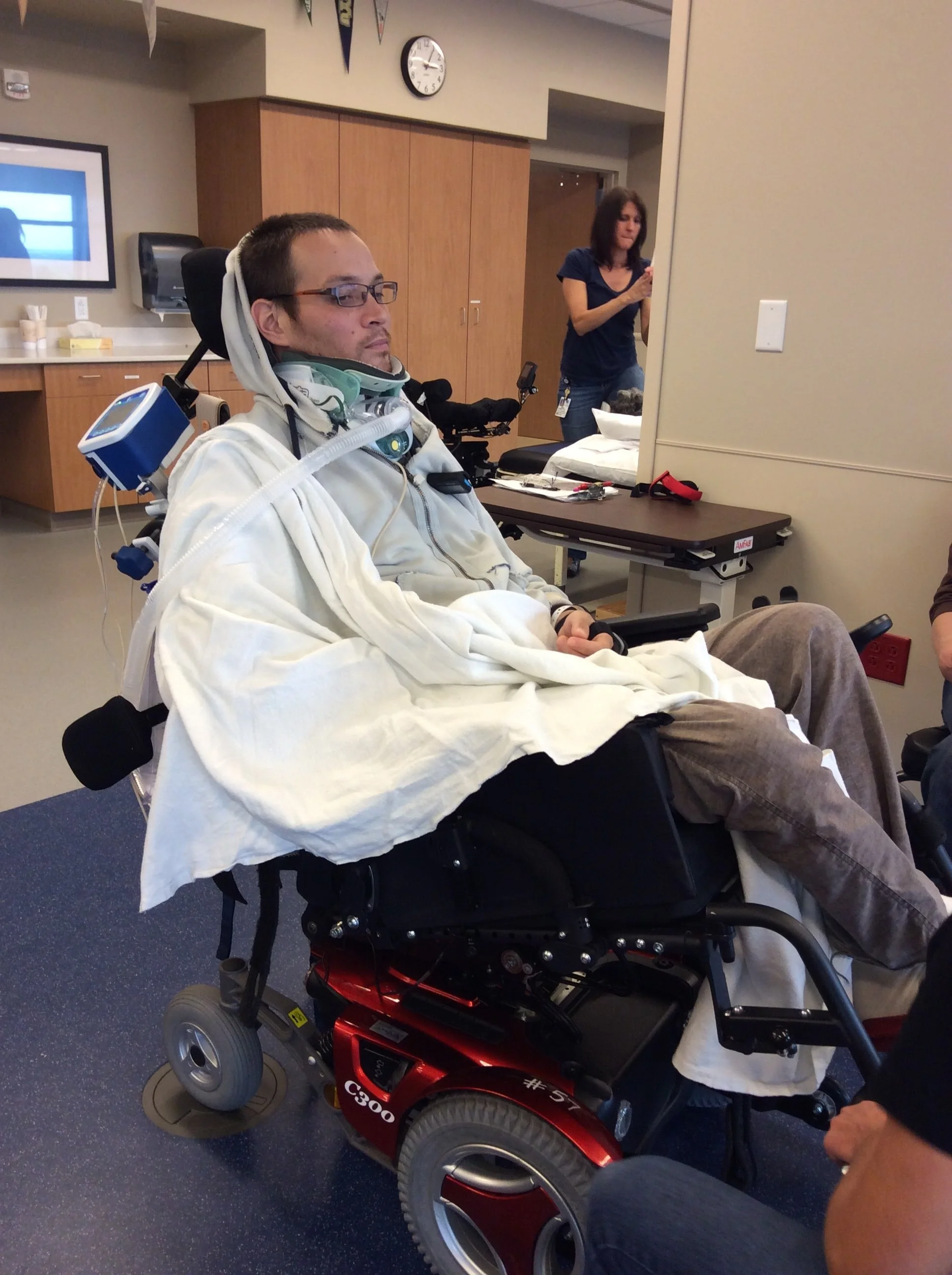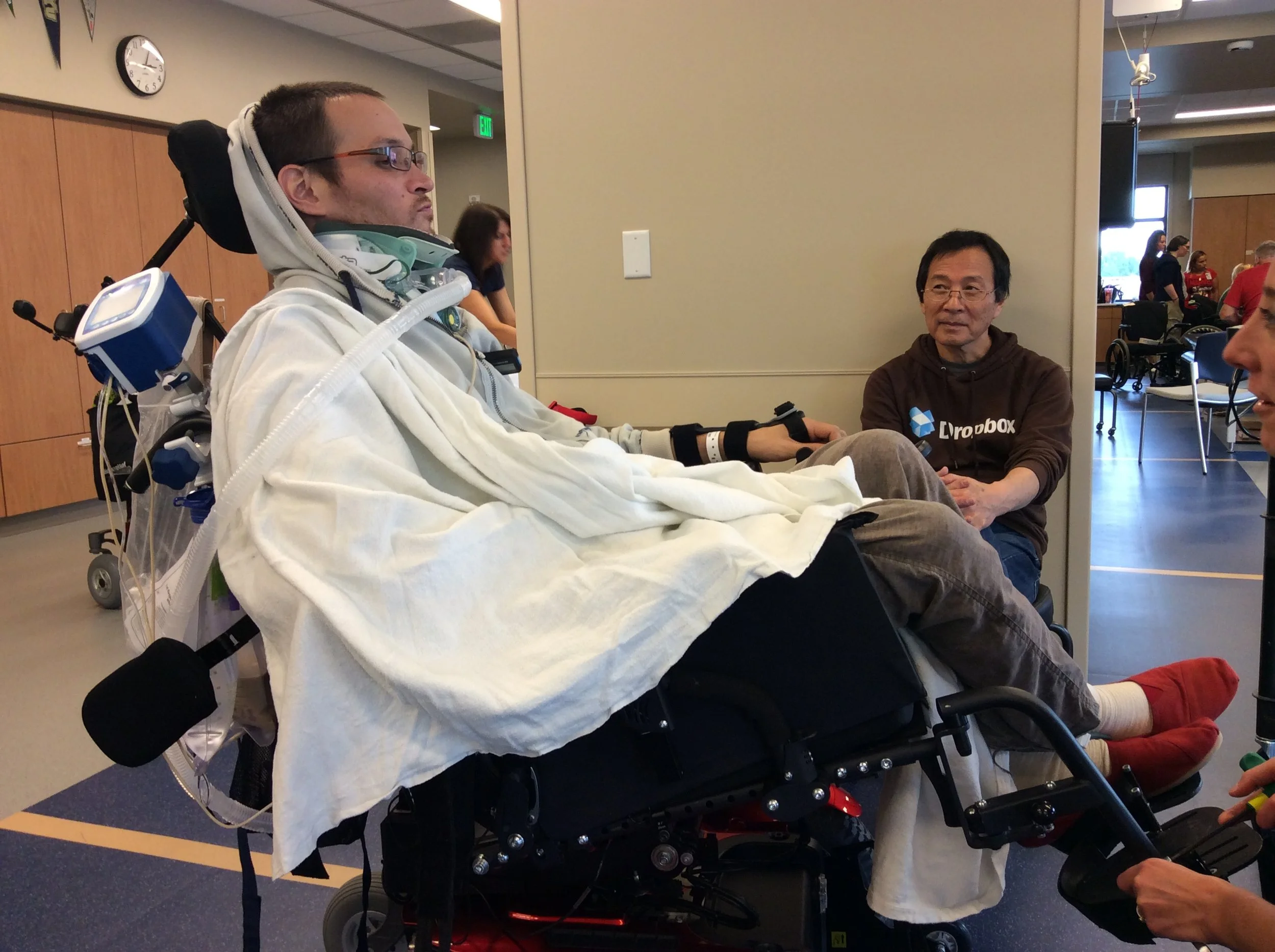Chapter 9 – Getting settled in
The first room I had at Craig Hospital was a two-patient room: I would have the spot next to the window and my roommate would have the spot on the other side of the partition, closer to the door. The thought of having a roommate brought about a lot of anxiety for a number of reasons. First, I didn’t really like being around people in the first place, so the idea of being trapped in a room with someone 24/7 for the foreseeable future was not ideal. Also, the social anxiety of “what if I make noise and annoy them? or what if I have to listen to their unbearable noises?” is constantly churning in my mind. However, all of this was put to rest when I got a bit more settled and they rolled me in front of the curtain to their half of the room. My roommate while I was staying in that room… The overflow of shower chairs and wheelchairs that were not being used; inanimate objects, my ideal roommate.
However, in these rooms, the patient’s family wasn’t supposed to stay and so they would be going next door to stay in the patient and family housing building. This also caused a fair amount of anxiety. I knew that if my family wasn’t staying in the room, I would be alone at night. Scenarios where I woke up struggling to breathe or where I was in significant pain or discomfort and needed help, played out over and over in my mind. It may seem silly but, while being in the hospital surrounded by medical staff should be reassuring, the difference between waking up not being able to breathe and trying to get someone’s attention across the room versus trying to hit a call button and hope there is someone on the other end who will magically appear to help and not assume it was an accidental call, felt enormous; more on that call system later. There was always hope of a room change to a suite, where my family would be able to stay in the room if they wanted, but for now this would be my situation; let’s be honest, I was in a great situation given everything that happened.
For the first few days after you arrive at the hospital you are not scheduled for any classes or therapies. I think it may have only been for two days but the whole “settling in” thing got old really fast. The room was a pretty standard hospital style room, with all the appropriate hookups on the wall for oxygen, vacuum, monitoring equipment, etc. so it wasn’t quite the change of scenery I had first imagined it would be. On top of that, when you’re lying in a hospital bed, even when you’re sat up, the view out the window doesn’t change and it becomes more of a painting than a movie. Add to that, not being able to see below the window line meant that all foot traffic and cars were also out of view, further eliminating any sense of change, any indication of the passage of time. Obviously, things changed, but nothing ever changed while you were watching; instead, if you looked back every hour or so it was like a spot the difference picture, with the shadows slightly shifted, a cloud that had wandered across the sky, and someone in the building across the street had opened their blinds. I’m pretty sure that by hour 4 or 5 I was already excruciatingly bored.
I have to say, it’s amazing how quickly you can get bored when you understand that you have no responsibilities beyond staying alive; I imagine this is why kids can be such a handful after only five minutes of inactivity. With nothing to occupy the mind on the grander scale, what is directly in front of you had better be pretty entertaining. I didn’t have to think about when I would eat next or how I would get that food; no thoughts of school, work, or socializing; hell, I didn’t even have to think about going to the bathroom. The lack of responsibilities all sounds great, but when it’s accompanied by the lack of access to the world that an infant might have, it loses its appeal quickly. Though, more than the boredom, I remember my dad and sister talking about what food they would get and from where. It all sounded so good, but given that I had tubes coming out of my throat, I wasn’t allowed to eat or drink anything in fear that I would aspirate it [inhale it, in a very literal sense].
When you can’t move anything except for your arm, and you can’t really control the motion of your arm when you move it, the options for things you can do are quite limited. Computers, phones, and books are literally and figuratively out of reach. No eating or drinking, so that’s out the window. Speaking of the window, yep, still nothing changing. Can’t talk because of the aforementioned tubes in the throat. It was going to be a long two days. The only thing left to do really was to study my room… Or what I could see of it. I distinctly remember there being laminated labels Velcroed to everything like a kindergarten classroom.
Somehow, I managed to pull through and survive two days of boredom (sarcasm). Two days after I arrived, I would meet two people who would become two of my favorite people during my time there. No offense to anyone else, there were just a handful of people who, because of commonalities in our personalities or just prolonged exposure, became particular sources of comfort or joy [I won’t be able to name them all here]. On that day, Emily, my nurse, and Mary, my physical therapist, came and helped lift me using the ceiling crane, into a manual wheelchair so I could be pushed around the campus. I wasn’t used to the transfer yet; the sling that goes behind you resembles a cartoon tooth, with the two legs of the teeth that are usually below the gum line going underneath you and up between your legs and then everything is attached to hooks up above. Not only does it feel pretty sketchy at first, but you also have the oxygen tubes leading to the trach and the feeding tubes that need to be kept out of the way and the oxygen source needs to be switched, which, at the time, seemed more significant than it actually was. However, this transfer would happen hundreds of times over my stay at Craig Hospital and even after with a portable version of the lift, and most of the time it was more amusing than anything else. I don’t know if it was just because enough time had passed and I was a bit stronger physically or if it was because of the chair’s ability to tilt back, basically dumping blood back into my head, but it was my first time being up in the chair and not feeling like I was constantly fighting to maintain consciousness.
Even though I could look out the window from the wheelchair, see everything that was going on outside, and feel the sun on my face, there’s something to the way sound travels outside that elevates all of your other senses; think of it like the difference between viewing a city through a window vs from an open balcony. Also, being outside and not feeling like I was on a physical timer, shifted the experience from one fraught with anxiety and sustained effort to a much-needed escape from existing solely within the walls of the hospital. Because of the portable oxygen source and other medical and safety concerns, you have to have a certified nursing assistant (CNA) with you to go outside. On my fourth day in the hospital, I finally got to go outside. They wheeled me out between East and West buildings of the hospital where there was a small courtyard with a fountain and a garden. The white noise from the fountain was just the right thing to mask the city noises. Also, being early September in Denver meant that it was pretty much the perfect temperature outside, and I could just sit with my eyes closed, let the sound of the fountain wash over me, and escape for just a few minutes before heading back inside.
As part of the orientation process, you receive a binder filled with information on spinal cord injuries. Not just some normal binder, but what felt like the largest size binder you could reasonably be expected to find without venturing online… ok, maybe not, but that’s the impression I got. It was an intimidating amount of information that covered just about anything you could possibly want to know [that we have reliable answers for]. There were different passes that let you get further away from your room with each successive level, and in order to obtain these passes you had to meet certain medical criteria and get through a given amount of the info in the binder. The first level pass basically allowed you to roam around the hospital outside of your room without a chaperone; they basically just need to make sure you aren’t going to just expire randomly and that whoever you are with knows how to problem solve any of the myriad of things that could come up, medically. I don’t have too many memories of the information in that binder, but I do remember a lot of it being quite helpful. However, one particular topic that I do remember quite vividly and that fundamentally changed me was pressure ulcers.
Now, thankfully, the first hospital I was in was knowledgeable and diligent in the prevention of these pressure ulcers, and because of this I was made aware of the topic. Reading through the materials those first days at Craig Hospital, it definitely seemed like something important, but a lot of things fit that bill at that time. It wasn’t until we got our video system working and I watched a video on pressure ulcers that shit got real. My sister and dad watched the video before me; my dad, who’s a doctor, didn’t seem particularly fazed, but my sister definitely did not seem entertained and gave me fair warning. I was expecting red patches or bruising with the top layer of skin broken, maybe a little bit of bleeding. I still have trouble getting over what I actually saw; gaping wounds, as if someone took an ice cream scoop and created a chasm, often exposing the bone beneath. Google image search “pressure ulcer,” if you ever wonder why I am constantly squirming around in my chair or doing weight shifts. If I feel the slightest bit of pain or discomfort, I start moving around as if they will amputate my leg if I don’t. Given the fact that my leg doesn’t work, it seems slightly odd to worry about, but if there’s one thing a handicapped person doesn’t want, it’s to become more handicapped. There is also the fact that there is the very real possibility that even a small pressure sore becomes fatal; the immune systems and healing ability of spinal cord injury patients can be significantly compromised… more on that later.
In just the 5 or so days that I had been at Craig Hospital, I had become much more tolerant of sitting up, so the thought of getting to try a power wheelchair was actually really exciting. Up to this point, I was entirely dependent on other people to move about, or even just to turn and look somewhere else. Also, the power chair had the ability to tilt the seat back and raise the legs, as many do, which let me do weight shifts where I could periodically take weight off of my butt for a bit and, as a bonus, it would dump blood back into my torso and head. It’s a wild feeling, it feels like someone is pouring energy back into your body; thinking and breathing become much easier, like having a portable charger for your energy, which still steadily drains when sitting upright. On that day, I was craned into my temporary manual wheelchair using the sling hanging from those ceiling rails, and they rolled me up to the 4th floor gym of the west building. As you pass through the double wide doors to the gym, the room opens up to reveal a number of islands of therapy mats on height adjustable platforms as you look forward or left. To the right, there was an open area with what looked like a set of gymnastics parallel bars, which are used to help people relearning to walk, along with a few other pieces of equipment. All along the far wall are windows which reveal a view of the Rocky Mountain front range south of Denver; looking out that window slowly turns from a temporary escape from the hospital to a painful reminder of a relationship, forever altered.
Anyway, I was rolled into the gym and we tried to find a spot where I could check out the view but also be out of everyone’s way. There were quite a few other patients in various states of disrepair, all either waiting for or working with their therapist(s). Sometimes it was one on one for the sessions, but other times there were whole teams of doctors, nurses, CNAs, and therapists working together to accomplish some goal. For that session, I was with just my OT Janessa, who is amazing and made even the most difficult and ego destroying tasks, something to just work through and giggle about. She was there to help setup and adjust the powerchair for me, which was a much more involved process than I could have imagined. First, there are obviously the dimensions of the frame. Along with that there are the dimensions and type of seat cushion and seatback, and there are a lot of choices. It doesn’t end there either, you have to choose and fit things like the foot plates, head rest, lateral supports, arm rests, joystick, guides for your legs, and on and on and on… If anything is off by enough, it can lead to discomfort, pain, pressure sores, or even just the general feeling that you don’t want to be in the chair. I found that with certain parts, such as the foot plate, if they are even slightly off, I notice a dramatic difference in my comfort; I can be a bit of a princess and the pea at times.
Being in that chair, however briefly, marked the first time I had really done anything for myself since the accident. I mean that quite literally, food, fluids, sitting up, turning, moving, going to the bathroom, etc. I was just a passive observer for it all. However, now that I was in this chair, with just a push of the joystick, I could move myself around the world again. Unfortunately for me, I would have to get out of the chair and give it back until the next day, when they could administer a little test to make sure I could control the chair and wouldn’t just come in like a 400 lb. wrecking ball.
The test to check my ability to control the chair, or lack thereof, was pretty simple from what I remember. We started by moving around the open space in the gym and then made our way through a series of doorways and hallways until we reached an empty hallway in front of some patient rooms. Once there, a series of small cones were set up on the floor as a temporary slalom course, and I was supposed to weave the chair between them without running them over. I was outrageously nervous despite the simplicity of the task. I think it was, in part, because I felt like they would take the chair away if I didn’t do well enough… which is literally the point of the test. I also thought that anything less than perfection was unacceptable, but also because it was just something that I thought that I should be good at, and I’d be embarrassed if I wasn’t. With a neck brace on, as soon as you get close to the cones they disappear from view, which fairly accurately represents trying not to run over people’s feet when you can see neither their feet nor your wheels. Either I put too much pressure on myself or the pressure is what made me perform, but I did fine. I zipped through the cones, staying close while avoiding running any of them over and got approval to use the chair. That would be my ride throughout my stay at Craig hospital until I began to trial other chairs when it was time to prescribe one for me. They don’t typically order chairs for people too early because it’s entirely possible you won’t need them. For example, while I was there, they ordered a power chair and a manual chair for a girl, but by the time they were scripted, approved, built, and shipped, she was walking and definitely didn’t need those chairs. Fun fact, those power wheelchairs are outrageously expensive, like, $24,000+ expensive.
One afternoon we were sitting in my room going over some random scheduling and logistics. My sister had handled just about everything outside of the hospital after my accident; from contacting my school, talking to my landlord, making sure bills were paid, acting as the point of contact for everyone, etc. My dad handled basically everything on the medical side of things and also made sure everything was covered financially. Things weren’t quite so black and white, but combined, they made sure that I didn’t have to worry about anything outside of my immediate vicinity. I was only half listening to her run through everything that was supposed to happen that week, when I heard,
“… aaand I signed up for a dying class later this week…”
“…excuse me but… uhhh, I’m dying!?”
I knew things were bad but I was not aware things were that grim… Also, is whoever named the class, the same person who named an Alzheimer’s benefit event “A Night to Remember”?
As it turns out, I had definitely misunderstood what she was saying and she was signed up for a “dyeing” class. While I was in the ICU and at Craig hospital, she had been stress-knitting; I came out with no less than six new hats, two new scarfs, and a new pair of socks. However, she had also been buying ugly cashmere sweaters and unraveling them to repurpose the yarn. In this process, sometimes she would dye the yarn a different color and had simply booked a spot in a class in Denver to learn how to do this properly; not, as I had thought, a spot in a class to deal with my death. A misunderstanding that still brings me joy to this day.
On the topic of misunderstandings, it had been about two weeks since I had tried to speak using the Passy-Muir valve back in the ICU. In that time my family and the hospital staff had created a board with all the typical complaints and requests you might have. So, when something was wrong, they could just run down the list and look for a positive response to one of the options. I guess it might be similar to playing Pictionary, but instead of drawing anything they just stared at you. If the standard list didn’t work and I needed something else, the alphabet was organized in small groups of letters. I would pick a group of letters then the individual letter, and repeat this process until I had spelled enough of the word or phrase for them to guess what I was trying to say. It was finally time to give the valve another try and see if I could ditch the board. There is a video of this attempt, the video lasts all of 7 seconds. I was very convinced it wasn’t going to work, or had at least tempered my excitement from the last time, which is all too apparent from the look on my face. Given the length of the video, you might be inclined to think it didn’t work, but in reality, I was just caught off guard when I was able to speak that I had no idea what to say. The first thing out of my mouth was just a protracted “uuhhhhhhhh…” à la Tina Belcher (Bob’s Burgers).
“So, what do you want to say,” my sister asks.
After a few seconds smiling, looking up at the ceiling, all I could come up with was, “I have no idea.” Over two weeks of not being able to speak and I still had nothing of interest to say.
The issue with the valve is that it makes breathing slightly more difficult and I didn’t have the stamina to deal with that long term. It’s like having a pin hole in your beach ball, it’s fine in short bursts but eventually it will be too deflated to be useful. This means that you have to work up to using the valve full time and also that they would take it off at night. That little valve basically represents your ability to speak, your voice; it’s a really strange feeling having someone physically disconnect your voice, place it in a box, and put it in a drawer across the room.
Idle conversation, or talking just to talk, has never been my thing. Will I occasionally just say boring inane bullshit from time to time because I feel awkward? For sure, but it’s as painful for me to hear come out of my mouth as it is for you to hear it. So, it didn’t matter that it had been weeks since I spoke, I didn’t have anything to say, but when I was in pain and could finally describe exactly what my problem was, it was absolutely the greatest thing. I can’t speak highly enough of the nurses and CNAs who manage to figure out what patients are thinking or feeling consistently without anything more than yes/ no responses and eye contact. Fucking amazing people, they deserve better pay and treatment.
We, as a society, do an atrocious job of both adequately compensating healthcare workers and protecting them from the physical and verbal abuse that is levied upon them on a daily basis, especially the nurses and CNAs who interact with patients the most. We have this habit of just labeling these types of people heroes and then calling their sacrifice noble instead of actually compensating them. Think of all the jobs labeled essential during the Covid-19 pandemic, how many of those jobs offer a comfortable lifestyle financially? But we called them heroes as they shouted for better pay and some protection.
In any case, the goal is to work up to a red cap [I’m not 100% sure if this is what they are called or if it was purely descriptive], which just seals off the tracheostomy tube, meaning you now have to inhale and exhale through your nose and mouth. It’s typically one of the last steps before the tracheostomy is removed, after gradually decreasing the size of the trach tube. Even with the red cap, they still take it away at night for a while before you are allowed to keep your voice 24/7. I still have that cap and the box they would put it in, my voice in a box. The thought crossed my mind that maybe they just took it away to get some peace and quiet… eh, even if, they deserve some peace and quiet… not that they actually got any.






